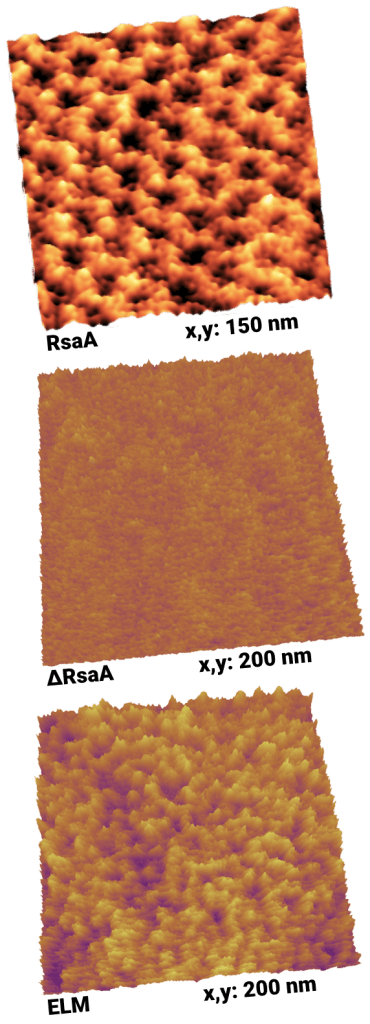We combine naturally occurring microbial systems and designer proteins to autonomously assemble functional living materials.
Just as wood has been a core regenerable material in society, we believe that engineered living materials (ELMs) based on bacteria are a promising path to truly sustainable materials. Microorganisms have the ability to self-assemble materials that are highly functional and with nanoscale patterning. We aim to program such materials, through pathways and protein engineering. Our work in this field started with S (`surface’)-layer proteins that form crystalline lattices on the outsides of many bacteria and archaea (see images on left). These nearly ubiquitous structures play a number of crucial biological roles: they serve as structural scaffolds, effect selective transport of ions and proteins, serve as templates for mineralization, and protect against phagocytosis. We exploit this surface structure to adhere materials to the cells, allowing them to interact and grow into macroscale living hydrogels. Our materials are produced from engineered genes in the cell and secreted, where they interact with cells, nanoparticles, and inorganic surfaces. We explore how alterations to secretion pathway, protein sequence, and cell ratios impact the material properties and can be controlled. Taking it a step further, we also engineer consortia of different bacterial strains to maximize the functional properties of our materials.
Here are some of our key papers on biomaterials:
“A de Novo Matrix for Macroscopic Living Materials from Bacteria,” Molinari, S., Tesoriero Jr., R.F., Li, D., Sridhar, S., Cai, R., Soman, J., Ryan, K.R., Ashby, P.D., & Ajo-Franklin, C.M., Nature Communications 13, 5544 (2022).
“Engineering high-yield biopolymer secretion creates an extracellular protein matrix for living materials,” M. Charrier, M. T. Orozco-Hidalgo, N. Tjahjono, D. Li, S. Molinari, K. R. Ryan, P. D. Ashby, B. Rad, C. M. Ajo-Franklin, mSystems, 6, e00903-20 (2021). *Editor’s Pick
“Bottom Up Approaches to Living Materials: Challenges and Future Directions,” S. Molinari, R. F. Tesoriero Jr, and C. M. Ajo-Franklin, Matter, 4, 3095-3120 (2021).
“Programmable assembly of 2D crystalline protein arrays into covalently stacked 3D bionanomaterials,” F. Manea, V. Garda, B. Rad, C. M. Ajo-Franklin, Biotechnology & Bioengineering, 117(4), 912-923 (2020).
“Engineering the S-layer of Caulobacter crescentus as a Foundation for Stable, High-Density, 2D Living Materials,” M. Charrier, D. Li, V. Mann, L. Yun, S. Jani, B. Rad, B. Cohen, P. Ashby, K. Ryan, & C. M. Ajo-Franklin, ACS Synthetic Biology, 8, 181–190 (2019). *Featured in Nature Chemical Biology

